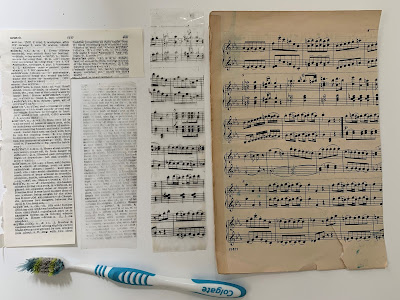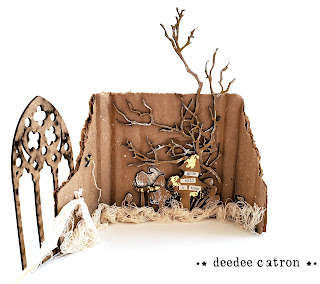I've had to break from Fodder School because my December was extra challenging but I'm so excited to get back to these lessons now. I'm on holiday so I've got some lovely play time ahead.
November's instructor in Fodder School was DeeDee Catron and you can find more about her HERE where I shared my stamp carving explorations. She shared 3 lessons about making fodder, the other two being chipboard alteration and image transfers. I realised I haven't shared what I did with those. I've done many image transfers before. See some ideas HERE and DeeDee shared a simple packing tape transfer which I first discovered via Julie Fei-Fan Balzer on YouTube. I tried it again just to make sure I remember how. The toothbrush was a really good way to get the wet paper off. Once dry the tape gets its stickiness back so you can apply it over other elements or use as you would patterned tape. Store on baking paper.Grungeboard is a product created by Tim Holtz and when it was first released (more than 10 years ago!) it was all the rage and I purchased and was gifted a bunch. From first glance it appears to be chipboard and can be treated the same as chipboard (painting, sanding, stamping, etc.), but it is pliable. You can bend it, distress it, and it won't rip like chipboard. You can stitch it which I also love. I used some of the shapes all those years ago for masking sprays, and I did this project creating a garden fairy - her wings are grungeboard.
If it wasn't for this class, it would all still be sitting in a drawer untouched....but now it's become part of my fodder keeper so more likely to get some use.
I decided that I wouldn't do DeeDee's final project at the moment, but I have lifetime access to this class so some of these techniques may just show up in a project in my future.
I was very excited as I saw interpretations from classmates of our lessons from our December instructor, Aimee Bishop. Her main project was these gorgeous mixed media amuletsI waited until now to start because there are so many amazing techniques to explore from the first part of the class before we even get to this project. Every teacher is hitting it out of the park for us!
First up I wanted to try some natural dyeing with fabrics and fibres I already had in my cupboards : aida cross stitch cloth, PFD (prepared for dyeing) white fabric, scrim (muslin), mulberry silk filament yarn, some old lace, tatting and serviettes.
Here's the tatting with an original bit on the right to see colour changes. Subtle but so lovely.The prepared for dye fabric and scrim had some variation where I used rubber bands for resist
Next up is mark making on papers and making embellishments. Will share soon.
See all my posts about Fodder School HERE. It's not too late to join us. DeeDee has also kept a record of where we can find any lessons that have been shared from the original #fodderchallenge in June 2021. All the artists featured there are going to be teachers in Fodder School.












